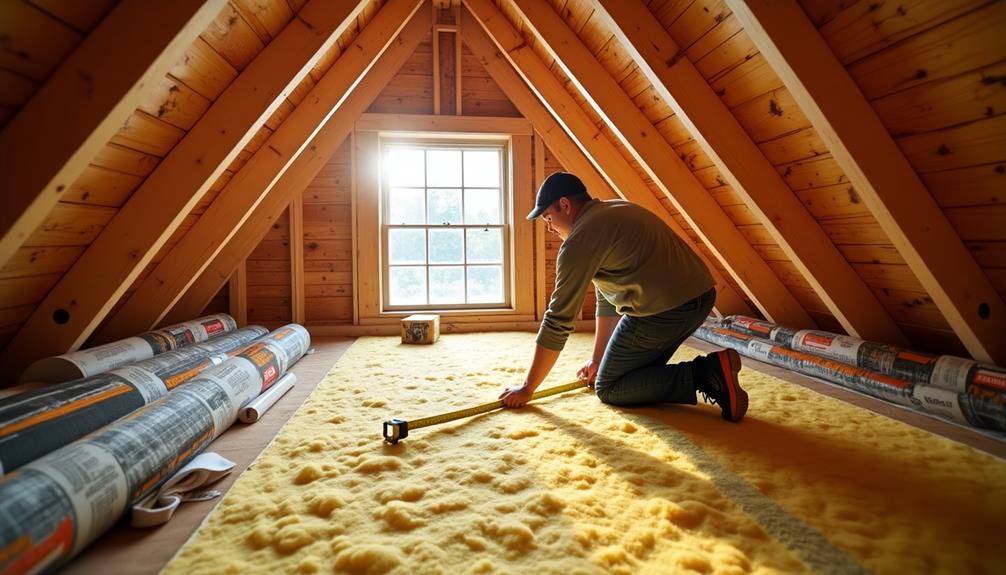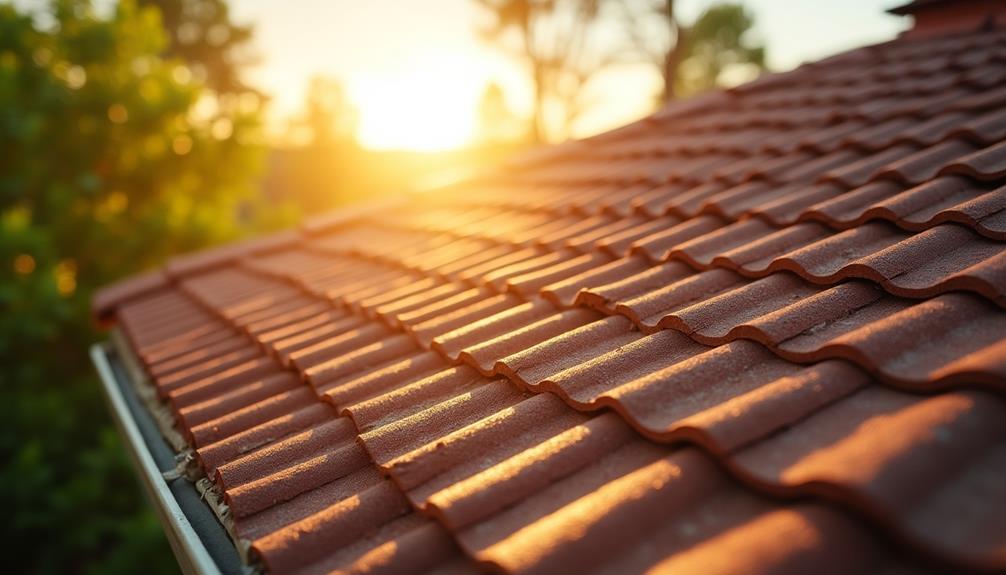To add insulation to your roof and boost energy efficiency, start by selecting the right insulation material, like spray foam or fiberglass batts. Measure the space between rafters, ensuring you cut the insulation to fit snugly without gaps. Lay it horizontally or spray foam directly into gaps, following manufacturer instructions. Secure the insulation with a staple gun while avoiding compression. Don't forget to inspect your roof for stable access points and use safety gear for protection. Regular maintenance and audits will help identify any inefficiencies in your insulation, ensuring optimal performance and savings for your home. You can discover more tips for effective installation.
Benefits of Roof Insulation
Considering the significant impact on energy efficiency, the benefits of roof insulation are hard to overlook.
First and foremost, proper insulation leads to substantial energy savings. By minimizing heat loss in winter and reducing heat gain in summer, you'll notice a significant decrease in your heating and cooling bills. This means more money in your pocket every month.
Moreover, roof insulation plays a crucial role in temperature regulation. It helps maintain a consistent indoor temperature, ensuring comfort throughout the year. You won't have to deal with those uncomfortable hot or cold spots that often plague poorly insulated homes.
By effectively managing your home's thermal dynamics, insulation enhances your living environment.
Additionally, roof insulation contributes to the longevity of your roofing materials. By preventing extreme temperature fluctuations, it reduces wear and tear, ultimately extending the life of your roof.
This means fewer repairs and replacements down the line, saving you time and hassle.
Types of Insulation Materials
When it comes to insulating your roof, choosing the right material is crucial for maximizing efficiency and comfort. Two popular options are spray foam and fiberglass batts, each with distinct advantages.
Spray foam insulation is known for its superior air sealing properties. It expands upon application, filling gaps and creating a tight seal that prevents air leaks. This not only enhances thermal performance but also helps control humidity, making it ideal for areas prone to moisture.
However, it can be more expensive than other options, so consider your budget.
On the other hand, fiberglass batts are a cost-effective choice for many homeowners. They come in pre-cut panels, making installation relatively straightforward. While they don't provide the same level of air sealing as spray foam, fiberglass batts can still effectively reduce heat transfer when installed correctly.
They're also non-combustible and resistant to mold, which adds to their appeal.
Ultimately, your choice between spray foam and fiberglass batts should depend on your specific needs, budget, and the climate in your area. Assessing these factors will help ensure you select the most effective insulation for your roof.
Preparation and Safety Measures
Before you start adding insulation to your roof, it's important to prepare your workspace and understand the safety measures involved.
First, inspect your roof access points. Ensure ladders are stable and positioned on solid ground to prevent falls. If you're using scaffolding, double-check it's properly assembled.
Next, equip yourself with appropriate safety gear. This includes a hard hat, non-slip footwear, safety goggles, and gloves. These items protect you from potential hazards such as falling debris or sharp materials.
Additionally, consider using a harness if you're working on a steep slope.
Clear the area of any obstacles that could cause tripping. Remove loose tools, materials, or debris before you begin.
If you'll be working in an attic space, ensure proper ventilation to avoid inhaling dust or fumes from insulation materials.
Installation Process Steps
The installation process for adding insulation to your roof involves several critical steps that ensure effectiveness and safety.
First, gather your installation tools, which typically include a utility knife, measuring tape, safety goggles, and a staple gun. You'll also need the appropriate insulation material, such as fiberglass batts or spray foam.
Begin by measuring the space between the roof rafters to determine the required insulation size. Cut the insulation to fit snugly within the rafters, avoiding gaps that could reduce efficiency.
If you're using batts, lay them horizontally between the rafters, ensuring they're flush against the roof deck. For spray foam insulation, follow the manufacturer's instructions. Typically, you'll spray the foam directly into the gaps, allowing it to expand and seal any voids. This technique provides an airtight barrier, enhancing energy efficiency.
Once installed, secure the insulation in place with your staple gun, ensuring it's held firmly without compression.
Maintenance and Performance Tips
Maintaining your roof insulation is crucial for optimal performance and energy efficiency. Regular upkeep ensures that your insulation continues to perform effectively, preventing heat loss in the winter and keeping your home cool in the summer.
Start by scheduling seasonal inspections. These checks help you identify any signs of damage or wear, such as moisture buildup or pest infestations, which can compromise your insulation's integrity.
In addition to inspections, consider conducting energy audits. These assessments can pinpoint areas where your insulation may be lacking. By analyzing your energy consumption patterns, you can determine whether your insulation is performing as it should. If you discover inefficiencies, it may be time to upgrade or add more insulation.
Also, pay attention to ventilation. Proper airflow prevents moisture accumulation, which can lead to mold growth and insulation degradation. Ensure vents are clear and functioning correctly.






